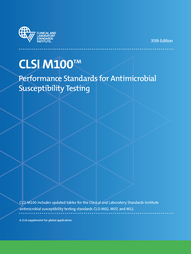CLSI M100
Performance Standards for Antimicrobial Susceptibility Testing
CLSI M100 is the gold standard for antimicrobial susceptibility testing, relied upon by laboratories worldwide to guide life-saving clinical decisions. This must-have resource provides the latest, evidence-based breakpoints and quality control parameters, ensuring that laboratories generate accurate, standardized results that clinicians trust for treating seriously ill patients.
Designed for use with CLSI M02 (disk diffusion), M07 (dilution for aerobic bacteria), and M11 (dilution for anaerobes), M100 delivers the most up-to-date tables for drug selection, result interpretation, and quality control (QC).
Don’t rely on outdated tables—download the most current edition today and maintain the highest standards in antimicrobial susceptibility testing.
{{FormatPrice(currentPrice)}}
Free
{{FormatPrice(nonMemberPrice)}} List PriceThe data in the tables are valid only if the methodologies in CLSI M02, M07 and M11 are followed. These standards contain information about disk diffusion (CLSI M02) and dilution (CLSI M07 and CLSI M11) test procedures for aerobic and anaerobic bacteria. Clinicians depend heavily on information from the microbiology laboratory for treating their seriously ill patients. The clinical importance of antimicrobial susceptibility test results demands that these tests be performed under optimal conditions and that laboratories have the capability to provide results for the newest antimicrobial agents. The tables presented in CLSI M100 represent the most current information for drug selection, interpretation, and quality control using the procedures standardized in CLSI M02, M07, and M11. Users should replace previously published tables with these new tables. Changes in the tables since the previous edition appear in boldface type.
CLSI M100-Ed35 replaces CLSI M100-Ed34, published in 2024. Major additions, reformatting, and/or table relocation changes are summarized below, followed by additional noteworthy changes detailed by section/table. Changes to content since the previous edition appear in boldface type; however, minor editorial or formatting changes are not listed here, nor highlighted in boldface type. To learn more about the organization of CLSI M100-Ed35, check the “Instructions for Use.” CLSI M100 is updated and reviewed annually as new data and new agents become available. Use of outdated documents is strongly discouraged.
The U.S. Food and Drug Administration (FDA) has evaluated and recognized this approved-level consensus standard for use in satisfying a regulatory requirement.
M100Ed34 M100Ed34E
The data in the tables are valid only if the methodologies in CLSI M02, M07 and M11 are followed. These standards contain information about disk diffusion (CLSI M02) and dilution (CLSI M07 and CLSI M11) test procedures for aerobic and anaerobic bacteria. Clinicians depend heavily on information from the microbiology laboratory for treating their seriously ill patients. The clinical importance of antimicrobial susceptibility test results demands that these tests be performed under optimal conditions and that laboratories have the capability to provide results for the newest antimicrobial agents. The tables presented in CLSI M100 represent the most current information for drug selection, interpretation, and quality control using the procedures standardized in CLSI M02, M07, and M11. Users should replace previously published tables with these new tables. Changes in the tables since the previous edition appear in boldface type.
CLSI M100-Ed35 replaces CLSI M100-Ed34, published in 2024. Major additions, reformatting, and/or table relocation changes are summarized below, followed by additional noteworthy changes detailed by section/table. Changes to content since the previous edition appear in boldface type; however, minor editorial or formatting changes are not listed here, nor highlighted in boldface type. To learn more about the organization of CLSI M100-Ed35, check the “Instructions for Use.” CLSI M100 is updated and reviewed annually as new data and new agents become available. Use of outdated documents is strongly discouraged.
The U.S. Food and Drug Administration (FDA) has evaluated and recognized this approved-level consensus standard for use in satisfying a regulatory requirement.
M100Ed34 M100Ed34E
